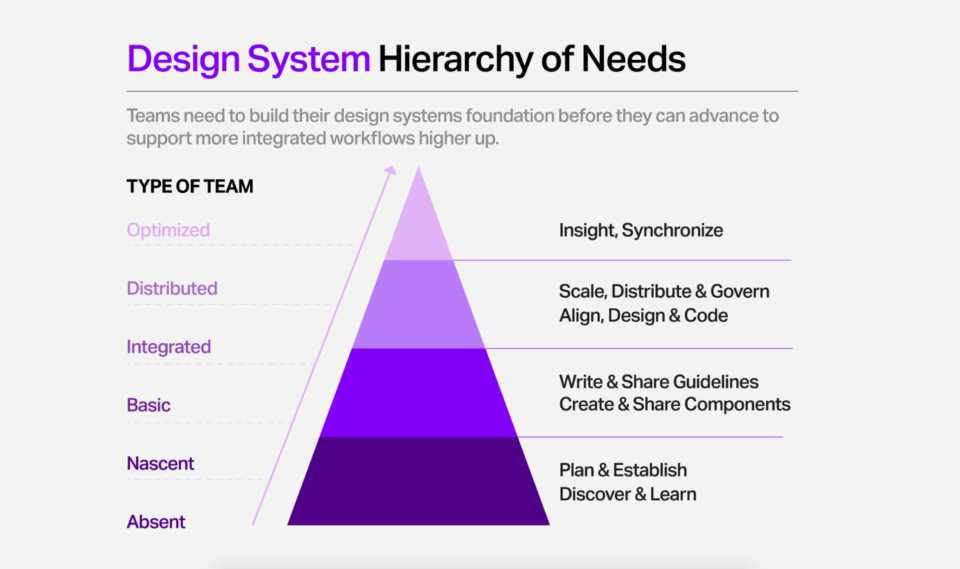While leading Design for InVision’s Design System Manager (DSM), I developed a framework for evaluating an organization’s design system maturity.
The Framework

The eBook “Guide to Benchmarking Your Design System” describes each level of this design system maturity spectrum in detail.
Methodology
I conducted qualitative user interviews with hundreds of design system makers and users and analyzed results from a quantitative analysis of the market to identify specific tasks and goals that design system makers have across different types of organizations.
I then sorted and grouped those tasks into logical progressive categories that captured major phases of design system evolution, noting prerequisites that were needed in order to advance to having a more mature system. Notably, these tasks ended up being very consistent across teams of differing sizes and industries. This made it possible to craft a universal framework.
Impact on the InVision DSM Product
The framework allowed our DSM Product team to:
- Quickly classify our users into persona groups
- Focus the product experience
- Progressively introduce more advanced product capabilities to more mature teams
- Offer tailored onboarding services
- Pinpoint where competitive products are focusing in relation to the maturity levels
Application in Advising Design System Teams
I have created a set of questions based on this framework to help design system teams evaluate where they are today, identify the challenges they’re facing, establish goals, and then identify the steps necessary to move forward to evolve their system.
1. Evaluate the state of the design system
Example Questions
- What building blocks are in place? What exists for design? Code?
- Have usage guidelines have been documented? If so, what information is covered?
- What processes are in place to govern the system?
- How is the system resourced? What is the team structure?
- How well is the design system adopted across the organization?
- What tooling, if any, is in place to measure usage?
Outcomes
- Identifies where the team is in the design system maturity spectrum
- Sets a baseline for defining next steps and goals
- Identifies any missing aspects of the system that are necessary for a successful foundation
- Establishes company investment
2. Identify Challenges
Example Questions
- What is preventing you from maturing your system?
- What is driving those challenges? Resourcing? Misalignment? Executive support? Skill gaps? Lack of shared priorities?
- What have you done to try to address those problems so far? What’s working and not working?
- How well aligned are design and code?
Outcomes
- Surfaces roadblocks
- Helps identify the source of issues
- Creates focus for brainstorming solutions
- Helps reduce risk of repeating what hasn't worked int he past
3. Establish Goals
Example Questions
- What does success look like?
- Is everyone aligned on this vision or are there differing perspectives?
- What is achievable in 6 months? 12 months?
- What needs to be instrumented in order to measure success?
- What milestones can be set?
Outcomes
- Creates a plan of action
- Aligns the organization
- Builds momentum
- Provides accountability
4. Set Next Steps
Example Questions
- What are the top priorities to fix within the current maturity stage?
- What can be started to make progress toward progressing to the next maturity stage?
- Who will own each next step?
- What are the target dates for each milestone?
- What status checks will be put in place?
- What needs to be done to ensure resource availability?
Outcomes
- The team is aligned on the top priorities
- Resources are committed
- Timelines and milestones are set
